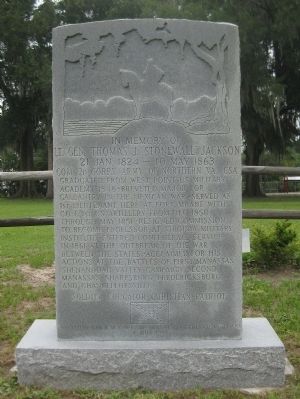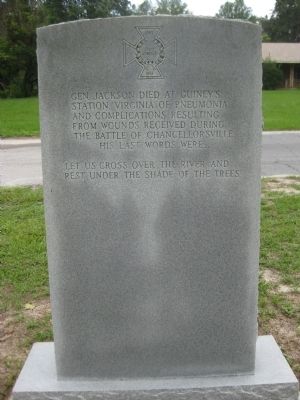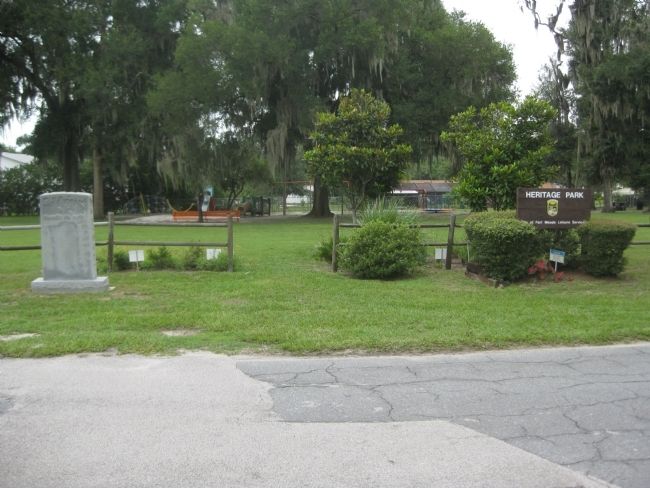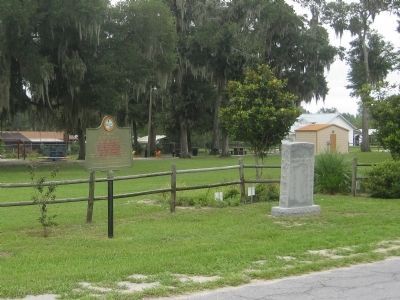Fort Meade in Polk County, Florida — The American South (South Atlantic)
Lt. Gen. Thomas J. "Stonewall" Jackson Memorial
1861 – Deo Vindice – 1865
Inscription.
(Front face)
Lt. Gen. Thomas J. "Stonewall" Jackson
21 Jan. 1824 - 10 May 1863
Com. 2d Corps. Army of Northern Va., CSA
Erected by Gen. E. M. Law Camp Sons of Confederate Veterans
4 July 1983
(Rear face)
Gen. Jackson died at Guiney's Station, Virginia of pneumonia and complications resulting from wounds received during the Battle of Chancellorsville.
"Let us cross over the river and rest under the shade of the trees."
Erected 1983 by Gen. E. M. Law Camp, Sons of Confederate Veterans.
Topics and series. This historical marker and memorial is listed in this topic list: War, US Civil. In addition, it is included in the Sons of Confederate Veterans/United Confederate Veterans series list. A significant historical date for this entry is May 10, 1863.
Location. 27° 45.319′ N, 81° 47.722′ W. Marker is in Fort Meade, Florida, in Polk County. Marker is on 3rd Street Northeast east of North Cleaveland Avenue, on the left when traveling east. The memorial stands in front of Heritage Park, a Fort Meade city park. Touch for map. Marker is in this post office area: Fort Meade FL 33841, United States of America. Touch for directions.
Other nearby markers. At least 8 other markers are within 5 miles of this marker, measured as the crow flies. Site of Fort Meade (here, next to this marker); The W. Henry Lewis House (approx. 0.2 miles away); Christ Church (approx. 0.2 miles away); Fort Meade Veterans Memorial (approx. half a mile away); Florida 2000 Center of Population (approx. half a mile away); Willoughby Tillis Battle Monument (approx. half a mile away); Historic Kissengen Spring (approx. 4.7 miles away); Homeland School (approx. 4.8 miles away). Touch for a list and map of all markers in Fort Meade.
More about this memorial. The marker is a two-sided granite monument. The upper third of the front face is filled by a relief carving showing the silhouette of a figure
mounted on horseback, atop a hill and under a canopy of trees and what appears to be Spanish moss. On the same side, near the base, is an engraving of a Confederate Battle Flag (rectangular variant).
The rear face is capped with an engraving of a wreath enclosed in a cross pattée, inside of which are inscribed 1861, Deo Vindice, and 1865.
The marker is placed at the actual site of the old Ft. Meade garrison where Jackson was once stationed.
Additional commentary.
1. Thomas Jonathan Jackson's Fearsome Quarrel with Superior Officer (French) at Ft. Meade Garrison
The Civil War podcast by Tracy and Richard Youngdahl, the most recent 38 minute episode (#138) is the first in a subseries about Jackson the man and his Shenandoah campaign that was Lee's effort to force the Lincoln administration to divert troops away from the Union effort to take Richmond. The Youngdahls' presentations are consistent with what I've studied about the war. They have read a huge amount of Civil War history and make book recommendations each episode. They're presenting the entire war as chronologically as possible so it's a perfect podcast for listeners who wish to achieve an excellent foundation for a comprehensive understanding of the war. This particular episode presents the problem Jackson
had with his superior officer (French) while he was at the Ft. Meade garrison, a dispute that got extremely nasty, complaints of the combatants making their way all the way to Winfield Scott in Washington. This episode may hold little relevance to the archaeological interpretation of the Ft. Meade garrison site, but it's certainly illustrative of Jackson's complicated and quirky character. A comprehensive 1,000 pg biography and another half that size are recommended at the end of the episode.
— Submitted January 12, 2016, by Jean Holland Bailey of Spartanburg, South Carolina.
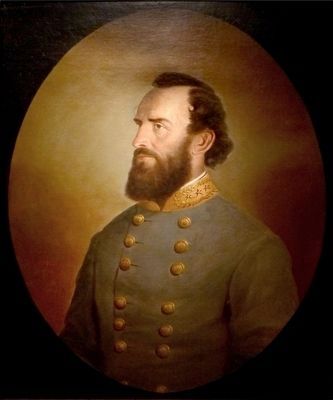
Photographed By Allen C. Browne, February 16, 2015
5. Thomas Jonathan "Stonewall" Jackson
This 1864 portrait of Thomas J. Jackson by J. W. King hangs in the National Portrait Gallery in Washington, DC.
“At the First Battle of Manassas in July 18th, the unrelenting vigor with which Confederate General Thomas Jonathan Jackson held his position inspired a general nearby to rally his troops with the cry, ‘There is Jackson standing like a stone wall.’ From that moment on, he was known as ‘Stonewall’ Jackson, a name that he repeatedly lived up to, fighting under the command of General Robert E. Lee.
The deeply religious Jackson believed intensely in the righteousness of the southern cause, and a key to his success was his ability to instill his own fighting fervor in his men. One of his most brilliant victories came at Chancellorsville in the spring of 1863. Tragically for Jackson and the South, this would prove to be his last battle, as he died of wounds accidentally inflicted by his own men.” — National Portrait Gallery
“At the First Battle of Manassas in July 18th, the unrelenting vigor with which Confederate General Thomas Jonathan Jackson held his position inspired a general nearby to rally his troops with the cry, ‘There is Jackson standing like a stone wall.’ From that moment on, he was known as ‘Stonewall’ Jackson, a name that he repeatedly lived up to, fighting under the command of General Robert E. Lee.
The deeply religious Jackson believed intensely in the righteousness of the southern cause, and a key to his success was his ability to instill his own fighting fervor in his men. One of his most brilliant victories came at Chancellorsville in the spring of 1863. Tragically for Jackson and the South, this would prove to be his last battle, as he died of wounds accidentally inflicted by his own men.” — National Portrait Gallery
Credits. This page was last revised on April 12, 2018. It was originally submitted on July 2, 2012, by Glenn Sheffield of Tampa, Florida. This page has been viewed 1,369 times since then and 76 times this year. Photos: 1, 2, 3, 4. submitted on July 2, 2012, by Glenn Sheffield of Tampa, Florida. 5. submitted on September 1, 2015, by Allen C. Browne of Silver Spring, Maryland. • Craig Swain was the editor who published this page.
